2009 Edition Chapter 8B. Signs and Markings
Section 8B.01 Purpose
Support:
01 Passive traffic control systems, consisting of signs and pavement markings only, identify and direct attention to the location of a grade crossing and advise road users to slow down or stop at the grade crossing as necessary in order to yield to any rail traffic occupying, or approaching and in proximity to, the grade crossing.
02 Signs and markings regulate, warn, and guide the road users so that they, as well as LRT vehicle operators on mixed-use alignments, can take appropriate action when approaching a grade crossing.
Standard:
03 The design and location of signs shall comply with the provisions of Part 2. The design and location of pavement markings shall comply with the provisions of Part 3.
Section 8B.02 Sizes of Grade Crossing Signs
Standard:
01 The sizes of grade crossing signs shall be as shown in Table 8B-1.
| Sign or Plaque | Sign Designation | Section | Conventional Road | Expressway | Minimum | Oversized | |
|---|---|---|---|---|---|---|---|
| Single Lane | Multilane | ||||||
| Stop | R1-1 | 8B.04, 8B.05 | 30 x 30 | 36 x 36 | 36 x 36 | — | 48 x 48 |
| Yield | R1-2 | 8B.04, 8B.05 | 36 x 36 x 36 | 48 x 48 x 48 | 48 x 48 x 48 | 30 x 30 x 30 | — |
| No Right Turn Across Tracks | R3-1a | 8B.08 | 24 x 30 | 30 x 36 | — | — | — |
| No Left Turn Across Tracks | R3-2a | 8B.08 | 24 x 30 | 30 x 36 | — | — | — |
| Do Not Stop on Tracks | R8-8 | 8B.09 | 24 x 30 | 24 x 30 | 36 x 48 | — | 36 x 48 |
| Tracks Out of Service | R8-9 | 8B.10 | 24 x 24 | 24 x 24 | 36 x 36 | — | 36 x 36 |
| Stop Here When Flashing | R8-10 | 8B.11 | 24 x 36 | 24 x 36 | — | — | 36 x 48 |
| Stop Here When Flashing | R8-10a | 8B.11 | 24 x 30 | 24 x 30 | — | — | 36 x 42 |
| Stop Here on Red | R10-6 | 8B.12 | 24 x 36 | 24 x 36 | — | — | 36 x 48 |
| Stop Here on Red | R10-6a | 8B.12 | 24 x 30 | 24 x 30 | — | — | 36 x 42 |
| Grade Crossing (Crossbuck) | R15-1 | 8B.03 | 48 x 9 | 48 x 9 | — | — | — |
| Number of Tracks (plaque) | R15-2P | 8B.03 | 27 x 18 | 27 x 18 | — | — | — |
| Exempt (plaque) | R15-3P | 8B.07 | 24 x 12 | 24 x 12 | — | — | — |
| Light Rail Only Right Lane | R15-4a | 8B.13 | 24 x 30 | 24 x 30 | — | — | — |
| Light Rail Only Left Lane | R15-4b | 8B.13 | 24 x 30 | 24 x 30 | — | — | — |
| Light Rail Only Center Lane | R15-4c | 8B.13 | 24 x 30 | 24 x 30 | — | — | — |
| Light Rail Do Not Pass | R15-5 | 8B.14 | 24 x 30 | 24 x 30 | — | — | — |
| Do Not Pass Stopped Train | R15-5a | 8B.14 | 24 x 30 | 24 x 30 | — | — | — |
| No Motor Vehicles On Tracks Symbol | R15-6 | 8B.15 | 24 x 24 | 24 x 24 | — | — | — |
| Do Not Drive On Tracks | R15-6a | 8B.15 | 24 x 30 | 24 x 30 | — | — | — |
| Light Rail Divided Highway Symbol | R15-7 | 8B.16 | 24 x 24 | 24 x 24 | — | — | — |
| Light Rail Divided Highway Symbol (T-Intersection) |
R15-7a | 8B.16 | 24 x 24 | 24 x 24 | — | — | — |
| Look | R15-8 | 8B.17 | 36 x 18 | 36 x 18 | — | — | — |
| Grade Crossing Advance Warning | W10-1 | 8B.06 | 36 Dia. | 36 Dia. | 48 Dia. | — | 48 Dia. |
| Exempt (plaque) | W10-1aP | 8B.07 | 24 x 12 | 24 x 12 | — | — | — |
| Grade Crossing and Intersection Advance Warning |
W10-2,3,4 | 8B.06 | 36 x 36 | 36 x 36 | 48 x 48 | — | 48 x 48 |
| Low Ground Clearance | W10-5 | 8B.23 | 36 x 36 | 36 x 36 | 48 x 48 | — | 48 x 48 |
| Low Ground Clearance (plaque) | W10-5P | 8B.23 | 30 x 24 | 30 x 24 | — | — | — |
| Light Rail Activated Blank-Out Symbol | W10-7 | 8B.19 | 24 x 24 | 24 x 24 | — | — | — |
| Trains May Exceed 80 MPH | W10-8 | 8B.20 | 36 x 36 | 36 x 36 | 48 x 48 | — | 48 x 48 |
| No Train Horn | W10-9 | 8B.21 | 36 x 36 | 36 x 36 | 48 x 48 | — | 48 x 48 |
| No Train Horn (plaque) | W10-9P | 8B.21 | 30 x 24 | 30 x 24 | — | — | — |
| Storage Space Symbol | W10-11 | 8B.24 | 36 x 36 | 36 x 36 | 48 x 48 | — | 48 x 48 |
| Storage Space XX Feet Between Tracks & Highway |
W10-11a | 8B.24 | 30 x 36 | 30 x 36 | — | — | — |
| Storage Space XX Feet Between Highway & Tracks Behind You |
W10-11b | 8B.24 | 30 x 36 | 30 x 36 | — | — | — |
| Skewed Crossing | W10-12 | 8B.25 | 36 x 36 | 36 x 36 | 48 x 48 | — | 48 x 48 |
| No Gates or Lights (plaque) | W10-13P | 8B.22 | 30 x 24 | 30 x 24 | — | — | — |
| Next Crossing (plaque) | W10-14P | 8B.23 | 30 x 24 | 30 x 24 | — | — | — |
| Use Next Crossing (plaque) | W10-14aP | 8B.23 | 30 x 24 | 30 x 24 | — | — | — |
| Rough Crossing (plaque) | W10-15P | 8B.23 | 30 x 24 | 30 x 24 | — | — | 36 x 30 |
Notes:
- Larger signs may be used when appropriate
- Dimensions in inches are shown as width x height
- Table 9B-1 shows the minimum sizes that may be used for grade crossing signs and plaques that face shared-use paths and pedestrian facilities
Option:
02 Signs larger than those shown in Table 8B-1 may be used (see Section 2A.11).
Section 8B.03 Grade Crossing (Crossbuck) Sign (R15-1) and Number of Tracks Plaque (R15-2P) at Active and Passive Grade Crossings
Standard:
01 The Grade Crossing (R15-1) sign (see Figure 8B-1), commonly identified as the Crossbuck sign, shall be retroreflectorized white with the words RAILROAD CROSSING in black lettering, mounted as shown in Figure 8B-2.
Figure 8B-1 Regulatory Signs and Plaques for Grade Crossings
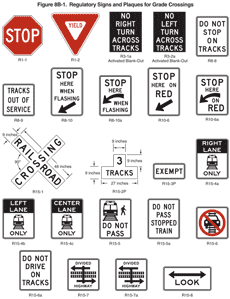
Support:
02 In most States, the Crossbuck sign requires road users to yield the right-of-way to rail traffic at a grade crossing.
Standard:
03 As a minimum, one Crossbuck sign shall be used on each highway approach to every highway-rail grade crossing, alone or in combination with other traffic control devices.
Option:
04 A Crossbuck sign may be used on a highway approach to a highway-LRT grade crossing on a semi-exclusive or mixed-use alignment, alone or in combination with other traffic control devices.
Standard:
05 If automatic gates are not present and if there are two or more tracks at a grade crossing, the number of tracks shall be indicated on a supplemental Number of Tracks (R15-2P) plaque (see Figure 8B-1) of inverted T shape mounted below the Crossbuck sign in the manner shown in Figure 8B-2.
Figure 8B-2 Crossbuck Assembly with a YIELD or STOP Sign on the Crossbuck Sign Support
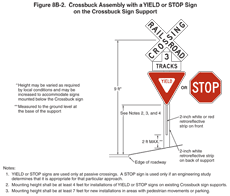
06 On each approach to a highway-rail grade crossing and, if used, on each approach to a highway-LRT grade crossing, the Crossbuck sign shall be installed on the right-hand side of the highway on each approach to the grade crossing. Where restricted sight distance or unfavorable highway geometry exists on an approach to a grade crossing, an additional Crossbuck sign shall be installed on the left-hand side of the highway, possibly placed back-to-back with the Crossbuck sign for the opposite approach, or otherwise located so that two Crossbuck signs are displayed for that approach.
07 A strip of retroreflective white material not less than 2 inches in width shall be used on the back of each blade of each Crossbuck sign for the length of each blade, at all grade crossings where Crossbuck signs have been installed, except those where Crossbuck signs have been installed back-to-back.
Guidance:
08 Crossbuck signs should be located with respect to the highway pavement or shoulder in accordance with the criteria in Chapter 2A and Figures 2A-2 and 2A-3, and should be located with respect to the nearest track in accordance with Figure 8C-2.
09 The minimum lateral offset for the nearest edge of the Crossbuck sign should be 6 feet from the edge of the shoulder or 12 feet from the edge of the traveled way in rural areas (whichever is greater), and 2 feet from the face of the curb in urban areas.
10 Where unusual conditions make variations in location and lateral offset appropriate, engineering judgment should be used to provide the best practical combination of view and safety clearances.
Section 8B.04 Crossbuck Assemblies with YIELD or STOP Signs at Passive Grade Crossings
Standard:
01 A grade crossing Crossbuck Assembly shall consist of a Crossbuck (R15-1) sign, and a Number of Tracks (R15-2P) plaque if two or more tracks are present, that complies with the provisions of Section 8B.03, and either a YIELD (R1-2) or STOP (R1-1) sign installed on the same support, except as provided in Paragraph 8. If used at a passive grade crossing, a YIELD or STOP sign shall be installed in compliance with the provisions of Part 2, Section 2B.10, and Figures 8B-2 and 8B-3.
Figure 8B-3 Crossbuck Assembly with a YIELD or STOP Sign on a Separate Sign Support
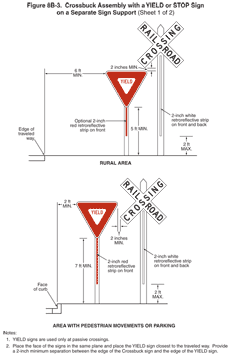
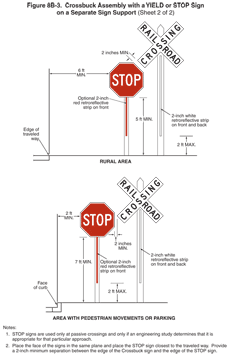
02 At all public highway-rail grade crossings that are not equipped with the active traffic control systems that are described in Chapter 8C, except crossings where road users are directed by an authorized person on the ground to not enter the crossing at all times that an approaching train is about to occupy the crossing, a Crossbuck Assembly shall be installed on the right-hand side of the highway on each approach to the highway-rail grade crossing.
03 If a Crossbuck sign is used on a highway approach to a public highway-LRT grade crossing that is not equipped with the active traffic control systems that are described in Chapter 8C, a Crossbuck Assembly shall be installed on the right-hand side of the highway on each approach to the highway-LRT grade crossing.
04 Where restricted sight distance or unfavorable highway geometry exists on an approach to a grade crossing that has a Crossbuck Assembly, or where there is a one-way multi-lane approach, an additional Crossbuck Assembly shall be installed on the left-hand side of the highway.
05 A YIELD sign shall be the default traffic control device for Crossbuck Assemblies on all highway approaches to passive grade crossings unless an engineering study performed by the regulatory agency or highway authority having jurisdiction over the roadway approach determines that a STOP sign is appropriate.
Guidance:
06 The use of STOP signs at passive grade crossings should be limited to unusual conditions where requiring all highway vehicles to make a full stop is deemed essential by an engineering study. Among the factors that should be considered in the engineering study are the line of sight to approaching rail traffic (giving due consideration to seasonal crops or vegetation beyond both the highway and railroad or LRT rights-of-ways), the number of tracks, the speeds of trains or LRT equipment and highway vehicles, and the crash history at the grade crossing.
Support:
07 Sections 8A.02 and 8A.03 contain information regarding the responsibilities of the highway agency and the railroad company or LRT agency regarding the selection, design, and operation of traffic control devices placed at grade crossings.
Option:
08 If a YIELD or STOP sign is installed for a Crossbuck Assembly at a grade crossing, it may be installed on the same support as the Crossbuck sign or it may be installed on a separate support at a point where the highway vehicle is to stop, or as near to that point as practical, but in either case, the YIELD or STOP sign is considered to be a part of the Crossbuck Assembly.
Standard:
09 If a YIELD or STOP sign is installed on an existing Crossbuck sign support, the minimum height, measured vertically from the bottom of the YIELD or STOP sign to the top of the curb, or in the absence of curb, measured vertically from the bottom of the YIELD or STOP sign to the elevation of the near edge of the traveled way, shall be 4 feet (see Figure 8B-2).
10 If a Crossbuck Assembly is installed on a new sign support (see Figure 8B-2) or if the YIELD or STOP sign is installed on a separate support (see Figure 8B-3), the minimum height, measured vertically from the bottom of the YIELD or STOP sign to the top of the curb, or in the absence of curb, measured vertically from the bottom of the YIELD or STOP sign to the elevation of the near edge of the traveled way, shall be 7 feet if the Crossbuck Assembly is installed in an area where parking or pedestrian movements are likely to occur.
Guidance:
11 If a YIELD or STOP sign is installed for a Crossbuck Assembly at a grade crossing on a separate support than the Crossbuck sign (see Figure 8B-3), the YIELD or STOP sign should be placed at a point where the highway vehicle is to stop, or as near to that point as practical, but no closer than 15 feet measured perpendicular from the nearest rail.
Support:
12 The meaning of a Crossbuck Assembly that includes a YIELD sign is that a road user approaching the grade crossing needs to be prepared to decelerate, and when necessary, yield the right-of-way to any rail traffic that might be occupying the crossing or might be approaching and in such close proximity to the crossing that it would be unsafe for the road user to cross.
13 Certain commercial motor vehicles and school buses are required to stop at all grade crossings in accordance with 49 CFR 392.10 even if a YIELD sign (or just a Crossbuck sign) is posted.
14 The meaning of a Crossbuck Assembly that includes a STOP sign is that a road user approaching the grade crossing must come to a full and complete stop not less than 15 feet short of the nearest rail, and remain stopped while the road user determines if there is rail traffic either occupying the crossing or approaching and in such close proximity to the crossing that the road user must yield the right-of-way to rail traffic. The road user is permitted to proceed when it is safe to cross.
Standard:
15 A vertical strip of retroreflective white material, not less than 2 inches in width, shall be used on each Crossbuck support at passive grade crossings for the full length of the back of the support from the Crossbuck sign or Number of Tracks plaque to within 2 feet above the ground, except as provided in Paragraph 16.
Option:
16 The vertical strip of retroreflective material may be omitted from the back sides of Crossbuck sign supports installed on one-way streets.
17 If a YIELD or STOP sign is installed on the same support as the Crossbuck sign, a vertical strip of red (see Section 2A.21) or white retroreflective material that is at least 2 inches wide may be used on the front of the support from the YIELD or STOP sign to within 2 feet above the ground.
Standard:
18 If a Crossbuck sign support at a passive grade crossing does not include a YIELD or STOP sign (either because the YIELD or STOP sign is placed on a separate support or because a YIELD or STOP sign is not present on the approach), a vertical strip of retroreflective white material, not less than 2 inches in width, shall be used for the full length of the front of the support from the Crossbuck sign or Number of Tracks plaque to within 2 feet above the ground.
19 At all grade crossings where YIELD or STOP signs are installed, Yield Ahead (W3-2) or Stop Ahead (W3-1) signs shall also be installed if the criteria for their installation in Section 2C.36 is met.
Support:
20 Section 8B.28 contains provisions regarding the use of stop lines or yield lines at grade crossings.
Section 8B.05 Use of STOP (R1-1) or YIELD (R1-2) Signs without Crossbuck Signs at Highway-LRT Grade Crossings
Standard:
01 For all highway-LRT grade crossings where only STOP (R1-1) or YIELD (R1-2) signs are installed, the placement shall comply with the requirements of Section 2B.10. Stop Ahead (W3-1) or Yield Ahead (W3-2) Advance Warning signs (see Figure 2C-6) shall also be installed if the criteria for their installation given in Section 2C.36 is met.
Guidance:
02 The use of only STOP or YIELD signs for road users at highway-LRT grade crossings should be limited to those crossings where the need and feasibility is established by an engineering study. Such crossings should have all of the following characteristics:
- The crossing roadways should be secondary in character (such as a minor street with one lane in each direction, an alley, or a driveway) with low traffic volumes and low speed limits. The specific thresholds of traffic volumes and speed limits should be determined by the local agencies.
- LRT speeds do not exceed 25 mph.
- The line of sight for an approaching LRT operator is adequate from a sufficient distance such that the operator can sound an audible signal and bring the LRT equipment to a stop before arriving at the crossing.
- The road user has sufficient sight distance at the stop line to permit the vehicle to cross the tracks before the arrival of the LRT equipment.
- If at an intersection of two roadways, the intersection does not meet the warrants for a traffic control signal as provided in Chapter 4C.
- The LRT tracks are located such that highway vehicles are not likely to stop on the tracks while waiting to enter a cross street or highway.
Section 8B.06 Grade Crossing Advance Warning Signs (W10 Series)
Standard:
01 A Highway-Rail Grade Crossing Advance Warning (W10-1) sign (see Figure 8B-4) shall be used on each highway in advance of every highway-rail grade crossing, and every highway-LRT grade crossing in semi-exclusive alignments, except in the following circumstances:
Figure 8B-4 Warning Signs and Plaques for Grade Crossings
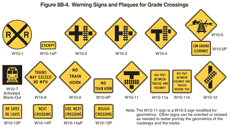
- On an approach to a grade crossing from a T-intersection with a parallel highway if the distance from the edge of the track to the edge of the parallel roadway is less than 100 feet and W10-3 signs are used on both approaches of the parallel highway;
- On low-volume, low-speed highways crossing minor spurs or other tracks that are infrequently used and road users are directed by an authorized person on the ground to not enter the crossing at all times that approaching rail traffic is about to occupy the crossing;
- In business or commercial areas where active grade crossing traffic control devices are in use; or
- Where physical conditions do not permit even a partially effective display of the sign.
02 The placement of the Grade Crossing Advance Warning sign shall be in accordance with Section 2C.05 and Table 2C-4.
03 A Yield Ahead (W3-2) or Stop Ahead (W3-1) Advance Warning sign (see Figure 2C-6) shall also be installed if the criteria for their installation given in Section 2C.36 is met. If a Yield Ahead or Stop Ahead sign is installed on the approach to the crossing, the W10-1 sign shall be installed upstream from the Yield Ahead or Stop Ahead sign. The Yield Ahead or Stop Ahead sign shall be located in accordance with Table 2C-4. The minimum distance between the signs shall be in accordance with Section 2C.05 and Table 2C-4.
Option:
04 On divided highways and one-way streets, an additional W10-1 sign may be installed on the left-hand side of the roadway.
Standard:
05 If the distance between the tracks and a parallel highway, from the edge of the tracks to the edge of the parallel roadway, is less than 100 feet, W10-2, W10-3, or W10-4 signs (see Figure 8B-4) shall be installed on each approach of the parallel highway to warn road users making a turn that they will encounter a grade crossing soon after making a turn, and a W10-1 sign for the approach to the tracks shall not be required to be between the tracks and the parallel highway.
06 If the W10-2, W10-3, or W10-4 signs are used, sign placement in accordance with the guidelines for Intersection Warning signs in Table 2C-4 using the speed of through traffic shall be measured from the highway intersection.
Guidance:
07 If the distance between the tracks and the parallel highway, from the edge of the tracks to the edge of the parallel roadway, is 100 feet or more, a W10-1 sign should be installed in advance of the grade crossing, and the W10-2, W10-3, or W10-4 signs should not be used on the parallel highway.
Section 8B.07 EXEMPT Highway-Rail Grade Crossing Plaques (R15-3P, W10-1aP)
Option:
01 When authorized by law or regulation, a supplemental EXEMPT (R15-3P) plaque (see Figure 8B-1) with a white background may be used below the Crossbuck sign or Number of Tracks plaque, if present, at the grade crossing, and a supplemental EXEMPT (W10-1aP) plaque (see Figure 8B-4) with a yellow background may be used below the Grade Crossing Advance Warning (W10 series) sign.
02 Where neither the Crossbuck sign nor the advance warning signs exist for a particular highway-LRT grade crossing, an EXEMPT (R15-3P) plaque with a white background may be placed on its own post on the near right-hand side of the approach to the crossing.
Support:
03 These supplemental plaques inform drivers of highway vehicles carrying passengers for hire, school buses carrying students, or highway vehicles carrying hazardous materials that a stop is not required at certain designated grade crossings, except when rail traffic is approaching or occupying the grade crossing, or the driver's view is blocked.
Section 8B.08 Turn Restrictions During Preemption
Guidance:
01 At a signalized intersection that is located within 200 feet of a highway-rail grade crossing, measured from the edge of the track to the edge of the roadway, where the intersection traffic control signals are preempted by the approach of a train, all existing turning movements toward the highway-rail grade crossing should be prohibited during the signal preemption sequences.
Option:
02 A blank-out or changeable message sign and/or appropriate highway traffic signal indication or other similar type sign may be used to prohibit turning movements toward the highway-rail grade crossing during preemption. The R3-1a and R3-2a signs shown in Figure 8B-1 may be used for this purpose.
Support:
03 LRT operations can include the use of activated blank-out sign technology for turn prohibition signs. The signs are typically used on roads paralleling a semi-exclusive or mixed-use LRT alignment where road users might turn across the LRT tracks. A blank-out sign displays its message only when activated. When not activated, the sign face is blank.
Guidance:
04 An LRT-activated blank-out turn prohibition (R3-1a or R3-2a) sign should be used where an intersection adjacent to a highway-LRT crossing is controlled by STOP signs, or is controlled by traffic control signals with permissive turn movements for road users crossing the tracks.
Option:
05 An LRT-activated blank-out turn prohibition (R3-1a or R3-2a) sign may be used for turning movements that cross the tracks.
06 As an alternative to LRT-activated blank-out turn prohibition signs at intersections with traffic control signals, exclusive traffic control signal phases such that all movements that cross the tracks have a steady red indication may be used in combination with No Turn on Red (R10-11, R10-11a, or R10-11b) signs (see Section 2B.53).
Standard:
07 Turn prohibition signs that are associated with preemption shall be visible or activated only when the grade crossing restriction is in effect.
Section 8B.09 DO NOT STOP ON TRACKS Sign (R8-8)
Guidance:
01 A DO NOT STOP ON TRACKS (R8-8) sign (see Figure 8B-1) should be installed whenever an engineering study determines that the potential for highway vehicles stopping on the tracks at a grade crossing is significant. Placement of the R8-8 sign should be determined as part of the engineering study. The sign, if used, should be located on the right-hand side of the highway on either the near or far side of the grade crossing, depending upon which position provides better visibility to approaching drivers.
02 If a STOP or YIELD sign is installed at a location, including at a circular intersection, that is downstream from the grade crossing such that highway vehicle queues are likely to extend beyond the tracks, a DO NOT STOP ON TRACKS sign (R8-8) should be used.
Option:
03 DO NOT STOP ON TRACKS signs may be placed on both sides of the track.
04 On divided highways and one-way streets, a second DO NOT STOP ON TRACKS sign may be placed on the near or far left-hand side of the highway at the grade crossing to further improve visibility of the sign.
Section 8B.10 TRACKS OUT OF SERVICE Sign (R8-9)
Option:
01 The TRACKS OUT OF SERVICE (R8-9) sign (see Figure 8B-1) may be used at a grade crossing instead of a Crossbuck (R15-1) sign and a Number of Tracks (R15-2P) plaque or instead of a Crossbuck Assembly when railroad or LRT tracks have been temporarily or permanently abandoned, but only until such time that the tracks are removed or covered.
Standard:
02 When tracks are out of service, traffic control devices and gate arms shall be removed and the signal heads shall be removed or hooded or turned from view to clearly indicate that they are not in operation.
03 The R8-9 sign shall be removed when the tracks have been removed or covered or when the grade crossing is returned to service.
Section 8B.11 STOP HERE WHEN FLASHING Sign (R8-10, R8-10a)
Option:
01 The STOP HERE WHEN FLASHING (R8-10, R8-10a) sign (see Figure 8B-1) may be used at a grade crossing to inform drivers of the location of the stop line or the point at which to stop when the flashing-light signals (see Section 8C.02) are activated.
Section 8B.12 STOP HERE ON RED Sign (R10-6, R10-6a)
Support:
01 The STOP HERE ON RED (R10-6, R10-6a) sign (see Figure 8B-1) defines and facilitates observance of stop lines at traffic control signals.
Option:
02 A STOP HERE ON RED sign may be used at locations where highway vehicles frequently violate the stop line or where it is not obvious to road users where to stop.
Guidance:
03 If possible, stop lines should be placed at a point where the highway vehicle driver has adequate sight distance along the track.
Section 8B.13 Light Rail Transit Only Lane Signs (R15-4 Series)
Support:
01 The Light Rail Transit Only Lane (R15-4 series) signs (see Figure 8B-1) are used for multi-lane operations, where road users might need additional guidance on lane use and/or restrictions.
Option:
02 Light Rail Transit Only Lane signs may be used on a roadway lane limited to only LRT use to indicate the restricted use of a lane in semi-exclusive and mixed alignments.
Guidance:
03 If used, the R15-4a, R15-4b, and R15-4c signs should be installed on posts adjacent to the roadway containing the LRT tracks or overhead above the LRT only lane.
Option:
04 If the trackway is paved, preferential lane markings (see Chapter 3D) may be installed but only in combination with Light Rail Transit Only Lane signs.
Support:
05 The trackway is the continuous way designated for LRT, including the entire dynamic envelope. Section 8B.29 contains more information regarding the dynamic envelope.
Section 8B.14 Do Not Pass Light Rail Transit Signs (R15-5, R15-5a)
Support:
01 A Do Not Pass Light Rail Transit (R15-5) sign (see Figure 8B-1) is used to indicate that motor vehicles are not allowed to pass LRT vehicles that are loading or unloading passengers where there is no raised platform or physical separation from the lanes upon which other motor vehicles are operating.
Option:
02 The R15-5 sign may be used in mixed-use alignments and may be mounted overhead where there are multiple lanes.
03 Instead of the R15-5 symbol sign, a regulatory sign with the word message DO NOT PASS STOPPED TRAIN (R15-5a) may be used (see Figure 8B-1).
Guidance:
04 If used, the R15-5 sign should be located immediately before the LRT boarding area.
Section 8B.15 No Motor Vehicles On Tracks Signs (R15-6, R15-6a)
Support:
01 The No Motor Vehicles On Tracks (R15-6) sign (see Figure 8B-1) is used where there are adjacent traffic lanes separated from the LRT lane by a curb or pavement markings.
Guidance:
02 The DO NOT ENTER (R5-1) sign should be used where a road user could wrongly enter an LRT only street.
Option:
03 A No Motor Vehicles On Tracks sign may be used to deter motor vehicles from driving on the trackway. It may be installed on a 3-foot flexible post between double tracks, on a post alongside the tracks, or overhead.
04 Instead of the R15-6 symbol sign, a regulatory sign with the word message DO NOT DRIVE ON TRACKS (R15-6a) may be used (see Figure 8B-1).
05 A reduced size of 12 x 12 inches may be used if the R15-6 sign is installed between double tracks.
Standard:
06 The smallest size for the R15-6 sign shall be 12 x 12 inches.
Section 8B.16 Divided Highway with Light Rail Transit Crossing Signs (R15-7 Series)
Option:
01 The Divided Highway with Light Rail Transit Crossing (R15-7) sign (see Figure 8B-1) may be used as a supplemental sign on the approach legs of a roadway that intersects with a divided highway where LRT equipment operates in the median. The sign may be placed beneath a STOP sign or mounted separately.
Guidance:
02 The number of tracks displayed on the R15-7 sign should be the same as the actual number of tracks.
Standard:
03 When the Divided Highway With Light Rail Transit Crossing sign is used at a four-legged intersection, the R15-7 sign shall be used. When used at a T-intersection, the R15-7a sign shall be used.
Section 8B.17 LOOK Sign (R15-8)
Option:
01 At grade crossings, the LOOK (R15-8) sign (see Figure 8B-1) may be mounted as a supplemental plaque on the Crossbuck support, or on a separate post in the immediate vicinity of the grade crossing on the railroad or LRT right-of-way.
Guidance:
02 A LOOK sign should not be mounted as a supplemental plaque on a Crossbuck Assembly that has a YIELD or STOP sign mounted on the same support as the Crossbuck.
Section 8B.18 Emergency Notification Sign (I-13)
Guidance:
01 Emergency Notification (I-13) signs (see Figure 8B-5) should be installed at all highway-rail grade crossings, and at all highway-LRT grade crossings on semi-exclusive alignments, to provide information to road users so that they can notify the railroad company or LRT agency about emergencies or malfunctioning traffic control devices.
Figure 8B-5 Example of an Emergency Notification Sign
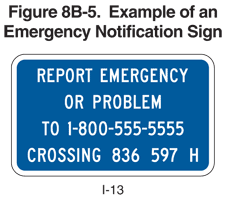
Standard:
02 When Emergency Notification signs are used at a highway-rail grade crossing, they shall, at a minimum, include the USDOT grade crossing inventory number and the emergency contact telephone number.
03 When Emergency Notification signs are used at a highway-LRT grade crossing, they shall, at a minimum, include a unique crossing identifier and the emergency contact telephone number.
04 Emergency Notification Signs shall have a white legend and border on a blue background.
05 The Emergency Notification signs shall be positioned so as to not obstruct any traffic control devices or limit the view of rail traffic approaching the grade crossing.
Guidance:
06 Emergency Notification signs should be retroreflective.
07 Emergency Notification signs should be oriented so as to face highway vehicles stopped on or at the grade crossing or on the traveled way near the grade crossing.
08 At station crossings, Emergency Notification signs or information should be posted in a conspicuous location.
09 Emergency Notification signs mounted on Crossbuck Assemblies or signal masts should only be large enough to provide the necessary contact information. Use of larger signs that might obstruct the view of rail traffic or other highway vehicles should be avoided.
Section 8B.19 Light Rail Transit Approaching-Activated Blank-Out Warning Sign (W10-7)
Support:
01 The Light Rail Transit Approaching-Activated Blank-Out (W10-7) warning sign (see Figure 8B-4) supplements the traffic control devices to warn road users crossing the tracks of approaching LRT equipment.
Option:
02 A Light Rail Transit Approaching-Activated Blank-Out warning sign may be used at signalized intersections near highway-LRT grade crossings or at crossings controlled by STOP signs or automatic gates.
Section 8B.20 TRAINS MAY EXCEED 80 MPH Sign (W10-8)
Guidance:
01 Where trains are permitted to travel at speeds exceeding 80 mph, a TRAINS MAY EXCEED 80 MPH (W10-8) sign (see Figure 8B-4) should be installed facing road users approaching the highway-rail grade crossing.
02 If used, the TRAINS MAY EXCEED 80 MPH signs should be installed between the Grade Crossing Advance Warning (W10 series) sign (see Figure 8B-4) and the highway-rail grade crossing on all approaches to the highway-rail grade crossing. The locations should be determined based on specific site conditions.
Section 8B.21 NO TRAIN HORN Sign or Plaque (W10-9, W10-9P)
Standard:
01 Either a NO TRAIN HORN (W10-9) sign (see Figure 8B-4) or a NO TRAIN HORN (W10-9P) plaque shall be installed in each direction at each highway-rail grade crossing where a quiet zone has been established in compliance with 49 CFR Part 222. If a W10-9P plaque is used, it shall supplement and be mounted directly below the Grade Crossing Advance Warning (W10 series) sign (see Figure 8B-4).
Section 8B.22 NO GATES OR LIGHTS Plaque (W10-13P)
Option:
01 The NO GATES OR LIGHTS (W10-13P) sign plaque (see Figure 8B-4) may be mounted below the Grade Crossing Advance Warning (W10 series) sign at grade crossings that are not equipped with automated signals.
Section 8B.23 Low Ground Clearance Grade Crossing Sign (W10-5)
Guidance:
01 If the highway profile conditions are sufficiently abrupt to create a hang-up situation for long wheelbase vehicles or for trailers with low ground clearance, the Low Ground Clearance Grade Crossing (W10-5) sign (see Figure 8B-4) should be installed in advance of the grade crossing.
Standard:
02 Because this symbol might not be readily recognizable by the public, the Low Ground Clearance Grade Crossing (W10-5) warning sign shall be accompanied by an educational plaque, LOW GROUND CLEARANCE. The LOW GROUND CLEARANCE educational plaque shall remain in place for at least 3 years after the initial installation of the W10-5 sign (see Section 2A.12).
Guidance:
03 Auxiliary plaques such as AHEAD, NEXT CROSSING, or USE NEXT CROSSING (with appropriate arrows), or a supplemental distance plaque should be placed below the W10-5 sign at the nearest intersecting highway where a vehicle can detour or at a point on the highway wide enough to permit a U-turn.
04 If engineering judgment of roadway geometric and operating conditions confirms that highway vehicle speeds across the tracks should be below the posted speed limit, a W13-1P advisory speed plaque should be posted.
Option:
05 If the grade crossing is rough, word message signs such as BUMP, DIP, or ROUGH CROSSING may be installed. A W13-1P advisory speed plaque may be installed below the word message sign in advance of rough crossings.
Support:
06 Information on ground clearance requirements at grade crossings is available in the "American Railway Engineering and Maintenance-of-Way Association's Engineering Manual," or the American Association of State Highway and Transportation Officials' "Policy on Geometric Design of Highways and Streets" (see Section 1A.11).
Section 8B.24 Storage Space Signs (W10-11, W10-11a, W10-11b)
Guidance:
01 A Storage Space (W10-11) sign supplemented by a word message storage distance (W10-11a) sign (see Figure 8B-4) should be used where there is a highway intersection in close proximity to the grade crossing and an engineering study determines that adequate space is not available to store a design vehicle(s) between the highway intersection and the train or LRT equipment dynamic envelope.
02 The Storage Space (W10-11 and W10-11a) signs should be mounted in advance of the grade crossing at an appropriate location to advise drivers of the space available for highway vehicle storage between the highway intersection and the grade crossing.
Option:
03 A Storage Space (W10-11b) sign (see Figure 8B-4) may be mounted beyond the grade crossing at the highway intersection under the STOP or YIELD sign or just prior to the signalized intersection to remind drivers of the storage space between the tracks and the highway intersection.
Section 8B.25 Skewed Crossing Sign (W10-12)
Option:
01 The Skewed Crossing (W10-12) sign (see Figure 8B-4) may be used at a skewed grade crossing to warn road users that the tracks are not perpendicular to the highway.
Guidance:
02 If the Skewed Crossing sign is used, the symbol should show the direction of the crossing (near left to far right as shown in Figure 8B-4, or the mirror image if the track goes from far left to near right). If the Skewed Crossing sign is used where the angle of the crossing is significantly different than 45 degrees, the symbol should show the approximate angle of the crossing.
Standard:
03 The Skewed Crossing sign shall not be used as a replacement for the required Advance Warning (W10-1) sign. If used, the Skewed Crossing sign shall supplement the W10-1 sign and shall be mounted on a separate post.
Section 8B.26 Light Rail Transit Station Sign (I-12)
Option:
01 The Light Rail Transit Station (I-12) sign (see Figure 2H-1) may be used to direct road users to an LRT station or boarding location. It may be supplemented by the name of the transit system and by arrows as provided in Section 2D.08.
Section 8B.27 Pavement Markings
Standard:
01 All grade crossing pavement markings shall be retroreflectorized white. All other markings shall be in accordance with Part 3.
02 On paved roadways, pavement markings in advance of a grade crossing shall consist of an X, the letters RR, a no-passing zone marking (on two-lane, two-way highways with center line markings in compliance with Section 3B.01), and certain transverse lines as shown in Figures 8B-6 and 8B-7.
Figure 8B-6 Example of Placement of Warning Signs and Pavement Markings at Highway-Rail Grade Crossings
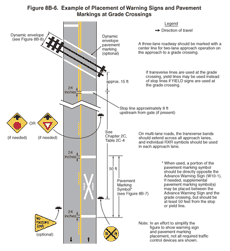
Figure 8B-7 Grade Crossing Pavement Markings
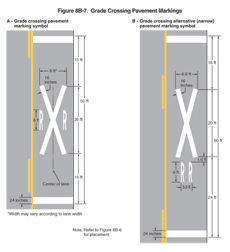
03 Identical markings shall be placed in each approach lane on all paved approaches to grade crossings where signals or automatic gates are located, and at all other grade crossings where the posted or statutory highway speed is 40 mph or greater.
04 Pavement markings shall not be required at grade crossings where the posted or statutory highway speed is less than 40 mph if an engineering study indicates that other installed devices provide suitable warning and control. Pavement markings shall not be required at grade crossings in urban areas if an engineering study indicates that other installed devices provide suitable warning and control.
Guidance:
05 When pavement markings are used, a portion of the X symbol should be directly opposite the Grade Crossing Advance Warning sign. The X symbol and letters should be elongated to allow for the low angle at which they will be viewed.
Option:
06 When justified by engineering judgment, supplemental pavement marking symbol(s) may be placed between the Grade Crossing Advance Warning sign and the grade crossing.
Section 8B.28 Stop and Yield Lines
Standard:
01 On paved roadways at grade crossings that are equipped with active control devices such as flashing-light signals, gates, or traffic control signals, a stop line (see Section 3B.16) shall be installed to indicate the point behind which highway vehicles are or might be required to stop.
Guidance:
02 On paved roadway approaches to passive grade crossings where a STOP sign is installed in conjunction with the Crossbuck sign, a stop line should be installed to indicate the point behind which highway vehicles are required to stop or as near to that point as practical.
03 If a stop line is used, it should be a transverse line at a right angle to the traveled way and should be placed approximately 8 feet in advance of the gate (if present), but no closer than 15 feet in advance of the nearest rail.
Option:
04 On paved roadway approaches to passive grade crossings where a YIELD sign is installed in conjunction with the Crossbuck sign, a yield line (see Section 3B.16) or a stop line may be installed to indicate the point behind which highway vehicles are required to yield or stop or as near to that point as practical.
Guidance:
05 If a yield line is used, it should be a transverse line (see Figure 3B-16) at a right angle to the traveled way and should be placed no closer than 15 feet in advance of the nearest rail (see Figure 8B-7).
Section 8B.29 Dynamic Envelope Markings
Support:
01 The dynamic envelope (see Figures 8B-8 and 8B-9) markings indicate the clearance required for the train or LRT equipment overhang resulting from any combination of loading, lateral motion, or suspension failure.
Figure 8B-8 Example of Dynamic Envelope Pavement Markings at Grade Crossings
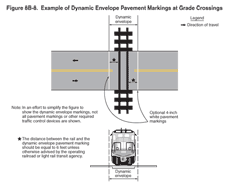
Figure 8B-9 Examples of Light Rail Transit Vehicle Dynamic Envelope Markings for Mixed-Use Alignments
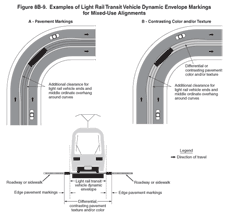
Option:
02 Dynamic envelope markings may be installed at all grade crossings, unless a Four-Quadrant Gate system (see Section 8C.06) is used.
Standard:
03 If used, pavement markings for indicating the dynamic envelope shall comply with the provisions of Part 3 and shall be a 4-inch normal solid white line or contrasting pavement color and/or contrasting pavement texture.
Guidance:
04 If pavement markings are used to convey the dynamic envelope, they should be placed completely outside of the dynamic envelope. If used, dynamic envelope pavement markings should be placed on the highway 6 feet from and parallel to the nearest rail unless the operating railroad company or LRT agency advises otherwise. The pavement markings should extend across the roadway as shown in Figure 8B-8. The dynamic envelope pavement markings should not be placed perpendicular to the roadway at skewed grade crossings.
Option:
05 In semi-exclusive LRT alignments, the dynamic envelope markings may be along the LRT trackway between intersections where the trackway is immediately adjacent to travel lanes and no physical barrier is present.
06 In mixed-use LRT alignments, the dynamic envelope markings may be continuous between intersections (see Figure 8B-9).
07 In mixed-use LRT alignments, pavement markings for adjacent travel or parking lanes may be used instead of dynamic envelope markings if the lines are outside the dynamic envelope.
